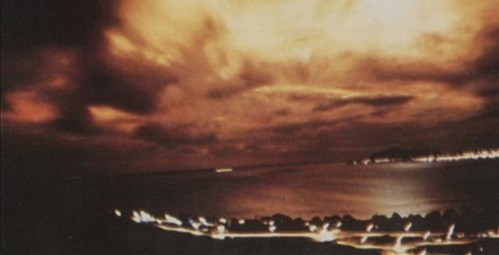Tick, Tock: EMP War Looms
If you want to cry after WannaCry ransomware attacked FedEx in the United States, hospitals in Britain, and telecommunications networks in Spain last Friday, you’ll want to bawl when North Korea hits the U.S. with an electromagnetic pulse (EMP). Let’s not go there.
Congressional reports and most security experts agree that America’s adversaries—from developed nations like China and Russia to dictatorships like Iran and North Korea—prefer to target our country with a triple threat combination of cyberattacks, physical damage and EMP. And EMP is the greatest threat of the three.
A unique menace in that it can occur naturally (via a geomagnetic storm) or by man (via the high-altitude detonation of a nuclear weapon), EMP is a rapid acceleration of particles that creates a high-power burst of electromagnetic energy.
55 years ago, during the Cold War, the United States experienced an accidental EMP blast when the JFK administration tested a 1.4-megaton nuclear warhead 250 miles above Johnston Atoll in the Pacific Ocean. The test, Operation Starfish Prime, malfunctioned. Traffic lights 850 miles away in Hawaii immediately went out, six satellites above the Pacific died, and radio networks were disrupted in Alaska, Hawaii and California.

Starfish Prime was a powerful warning—had we listened. Unfortunately, today our country is virtually defenseless against an EMP attack.
Furthermore, the ramifications of an EMP attack in 2017 are far greater than in 1962 due to the proliferation of grid-dependent smartphones, computers, cars, medical facilities, financial institutions and food distribution channels. Even our military is far more electricity-dependent.
“Electricity could be out for months or years because the grid would need to be assembled completely anew since its components would melt,” EMP expert Avi Schurr told NATO. Hospitals, banks, and grocery stores would be unable to function for months—and possibly permanently. Without power or communications systems, chaos would erupt and tens of millions of Americans would die.
The good news? We know how to prevent an EMP attack—and with a relatively modest monetary investment.
The bad news? More than any president in U.S. history, Barack Obama had unique congressional studies at his fingertips alerting him to the danger of an EMP attack, plus manifold prevention recommendations from the congressional EMP Commission. Yet Obama only took steps to weaken America’s already-anemic defenses.
We must encourage President Trump to right Obama’s failure and take immediate action to harden America’s military and civilian electrical grid and infrastructure.
Building an EMP Defense
“Peace through strength.” Ronald Reagan said it. President Trump said it. Whether you’re playing tennis or the high-stakes sport of international relations, a good offense is a good defense. We will promote peace in America—and the world—by building a strong EMP defense program:
Grow our ballistic missile arsenal:The U.S. military should continue to develop missile defenses capable of intercepting enemy missiles mid-projection. This should be our number one priority for EMP defense.
Unfortunately, the Obama administration throttled the U.S. with self-imposed missile defense restrictions when he signed the New Strategic Arms Reduction Treaty (New START). He also cut or cancelled several existing missile defense programs, such as Airborne Laser.
EMP hardening of civilian systems: Our electrical grid and primary infrastructure should be hardened against cyber and EMP attacks. Hardening civilian infrastructure is particularly important given that, as Heritage foundation points out: “The U.S. military has increasingly incorporated civilian technology not designed to resist EMP attack into its systems.”
Congressional and Private Sector Action: Sen. Lisa Murkowski (R-Alaska) chairs the Senate Energy and Natural Resources Committee. Unlike most of our representatives who have pushed the issue of EMP under the rug, Murkowski has actively worked to bring public and private sectors together to defend America against an EMP burst.
On Thursday, Murkowski announced her public support for Trump’s appointees to fill vacancies on the Federal Energy Regulatory Commission (FERC)—the government agency tasked with the safeguarding of our energy infrastructure. Trump appointed Rob Powelson and Neil Chatterjee.
Congress should prioritize approval of Trump’s choices and then work with the private sector to set standards and implement policy to prevent EMP bursts.
Support State Efforts: Last week, Texas Sen. Bob Hall introduced Senate Bill 83 in the Texas State legislature to protect the Texas power grid against a nuclear EMP attack. Texas is in a unique position in that its electric power grid is entirely independent from the nation’s grid. SB 83 would require the state to develop an EMP prevention plan by September 1 of 2018.
Alaska and New York have also taken steps to secure their state’s infrastructure in recent years. The Trump administration should publicly support such efforts to harden and secure infrastructure—and encourage other states to follow suit.
“The chief impediment to protecting our grid and our country from EMP is not technical—we know how to do it. We’ve known how to do it for 50 years. The chief impediment is political,” says Congressional EMP Commission chief of staff Dr. Peter Pry.
President Trump, you know what to do. Don’t repeat President Obama’s mistakes. Take action now to prevent a catastrophic EMP attack that could turn America into a wasteland overnight.





